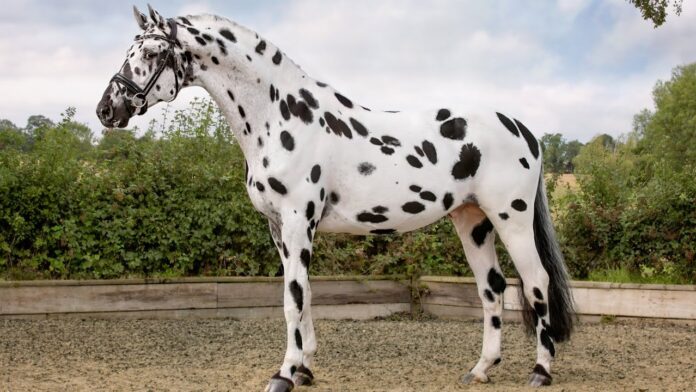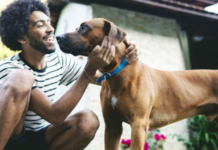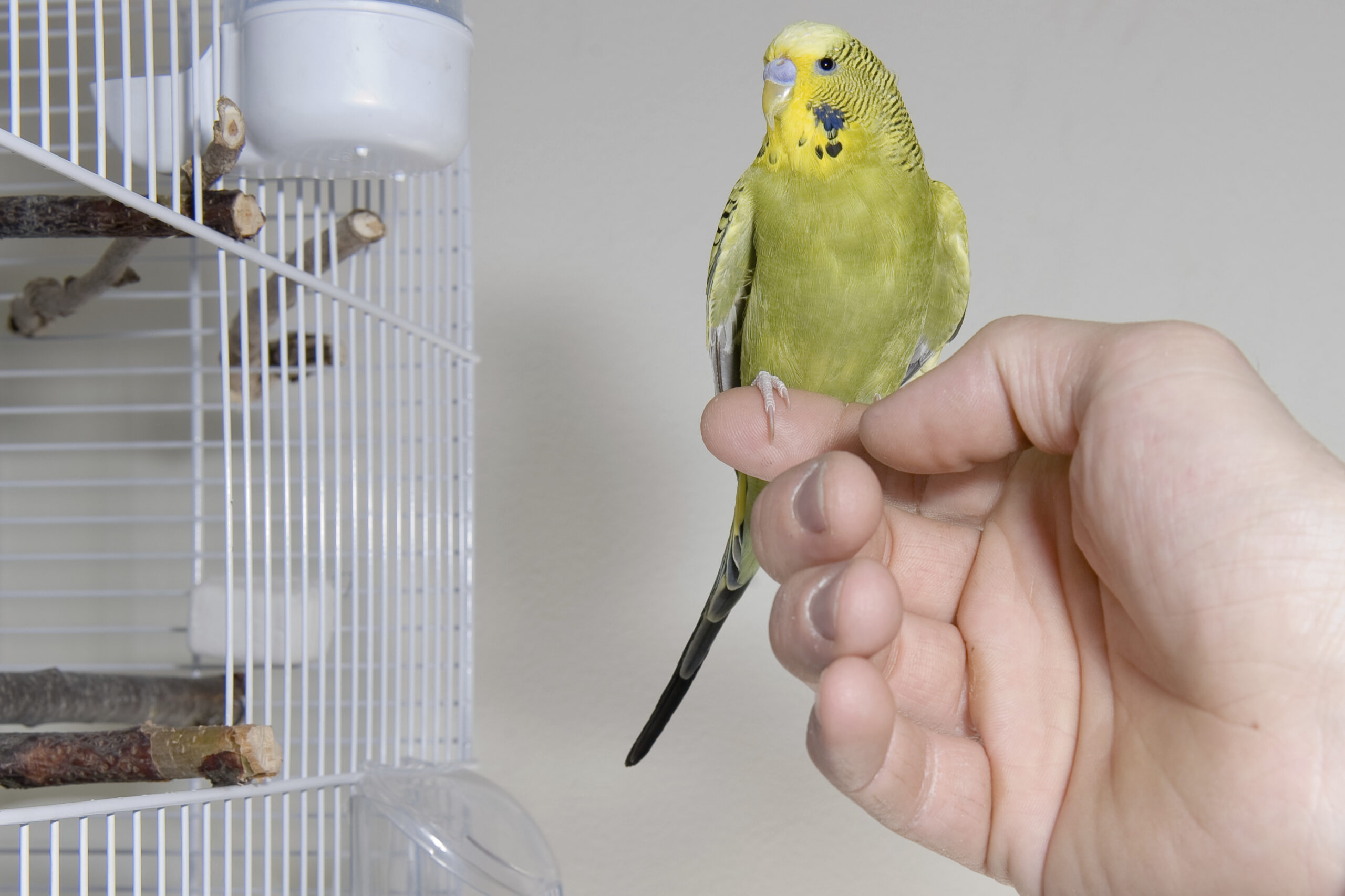Last Updated on October 10, 2023 by Fumipets
Knabstrupper Horse: The Beautiful Spotted Equine Breed
The Knabstrupper horse is a unique and striking breed known for its distinctive spotted coat pattern, similar to that of the Appaloosa.
Originating in Denmark, these horses have a rich history and are prized for their versatility, grace, and friendly temperament. This breed has found favor in various equestrian disciplines, including dressage, show jumping, and driving.
Knabstrupper Horse
The Knabstrupper horse is a magnificent and unusual horse breed with a captivating appeal and, certainly, a lovely name to say.
When seen from a distance, a herd of Knabstruppers may be mistaken for a group of enormous leopards. Yet, they are really a herd of calm horses who are renowned for their stamina, speed, and, of course, their eye-catching spotted coat.
The Knabstrupper horse has intriguing characteristics that you should be aware of, including its history and temperament. Continue to read to learn more.
Quick Facts About the Knabstrupper Horse
| Species Name: | Equus ferus caballus |
| Family: | Equidae |
| Care Level: | Medium |
| Temperature: | 18-59 degrees Fahrenheit |
| Temperament: | Gentle, people-oriented, athletic, willing to work, friendly, multi-talented, trainable, intelligent, hardy, docile |
| Color Form: | Solid with a few leopard spots, near leopard, spotted blanket, snowflake, white blanket, frosted blanket, marble |
| Lifespan: | 27.5 years |
| Size: | 15.2-16 hands (height) ,1150 pounds (weight) |
| Diet: | Hay, pasture grass, limited oat and corn, occasional treats like carrots and candy, vegetables, concentrate mix, salt and mineral supplements, plenty of fresh and clean water |
| Enclosure Size: | 12 by 12 feet, 10 feet high |
| Compatibility: | Appaloosa |
Knabstrupper Horse Overview
Knabstrupper horses are a very young breed in the United States since they were not brought over from Europe until 2002. Yet, their ancestors may be traced to the ancient spotted equines that were indigenous to modern-day Spain according to cave drawings.
The contemporary Knabstrupper originated in Denmark in 1812 as a result of mating a solid-colored Frederiksborg stallion with Flaebehoppen, a chestnut mare with intricate leopard patterns.
This mating gave birth to a colt with striking spots who was mated to other superior horses and produced Knabstruppers, another brightly colored progeny.
Before the 1870s, when this uncommon gene pool started to experience problems due to inbreeding, this breed of horse was among the most sought-after in Europe.
The rare Danish spotted horses were endangered by inbreeding and a fire that killed 22 of the finest Knabstruppers in 1891.
Nonetheless, a small number of devoted horse owners worked to preserve the breed alive. In 1971, three imported Appaloosa stallions provided the Knabstruppers with a lifeline.
Because of their similar Spanish lineage, the Appaloosa stallion helped the Knabstrupper come back to life. Despite this, there are just 600 members of this breed left in the whole globe.
Depending on the breed, these horses are used for a variety of activities nowadays. The Sport horse competes in dressage, exhibitions, and show jumping. Pony Knabstruppers are a kid’s favorite, while other classic type Knabstruppers are well-liked as circus horses, classic riding, and driving.

How Much Do Knabstrupper Horses Cost?
These oldest horse breeds in Europe are suitable for both carrying weights and participating in sports. They also come in a variety of designs, allowing hopeful owners to acquire as much flare as possible in a Knabstrupper, which is associated with athleticism and polite personalities.
Younger Knabstruppers may thus be rather expensive, particularly if they come from a reputable bloodline. Owners-to-be should prepare to spend between $5,000 and $11,000.
Typical Behavior & Temperament
Regardless of the kind of choice, all Knabstruppers are graceful, athletic, vivacious but composed, and enthused yet submissive. As they have spent the majority of the year outside rather than in stables, these horses are also “easy keepers” and resilient.
Knabstruppers are trainable, enthusiastic, sociable, polite, ready to work, and very tenacious. Also, they are kind and willing to please, which is why the Pony Knabstruper is a play horse for kids.
Appearance & Varieties
The spots and different coat patterns that vary from plain (yes, not all Knabstruppers are spotty) with a few leopard spots to complete leopard patterns are what make a Knabstrupper unique.
The most prevalent design is the “leopard” pattern, which is plain white with spots that might be bay, black, or chestnut in color.
Knabstruppers are a “color” species, and the bloodlines of each horse determine the size and conformation of each individual.
While they may be taller, horses typically stand between 15.2 and 16 hands tall. There are also Knabstrupper Ponies, most of whom are under 14.2 hands high.
There are three variations of this breed of horse: sport horses, classic horses, and ponies.
The Sport Knabstrupper stands 15.2 to 16 hands tall, has a greater warmblood influence, and is taller and slimmer. Sport Horse breeds excel in show jumping, dressage, and events.
Classical Horse types, commonly referred to as the Baroque type, have a more classical build and are closer to the original breed. They are utilized to drive carriages and perform military operations since they are shorter, stronger, and wider.
Pony Knabstruppers are the children’s favorite because of their captivating colors and amiable personalities. They are less than 14.2 hands tall. Shetland-sized ponies with the traditional Knabstrupper’s colors have been generated via further breeding.
Knabstruppers have strong, proportionate bodies that support expressive heads with tiny ears and clear eyes. In addition, they have well-balanced necks, sloping shoulders, strong backs, and well-defined limbs that finish in well-defined hooves.
They seem comfortable and graceful overall thanks to their physique. For instance, Knabstruppers, who may weigh up to 1150 pounds, walk with a light, beautiful, and elegant gait.

How to Take Care of Knabstrupper Horse
Habitat
Enclosure
While they are easy-keepers and want their enclosure to be as natural as possible, knabstrupper horses may live both outdoors and inside the stable.
To provide your horse with a space to go outside, run about, exercise, graze, socialize with other horses, and come and go at will, you may create a run-in shelter.
To enable the horse to leap, sleep, and turn about without hurting itself, the shelter should have three sides, be at least 12 by 12 feet in size for one horse, and be at least 10 feet high.
To protect your horse from the elements, such as the cold, excessive sunshine, wind, and severe temperatures, you may also put them in stables or barns at night. The stalls must be tall and roomy enough for the horse to comfortably lay down and rest.
Make sure the door is wide enough for them to get in and out without getting harmed.
Bedding
The bedding in a Knabstrupper’s stall has to be of high quality and kind to horses. The bed should always be clean and dry since it cushions and insulates the floor surface.
You don’t want a bedding material that tempts your horse to eat, so think about how tasty it is. In order to quickly absorb urine and easily decrease the production of ammonia fumes, it should also be soft and very absorbent. For bedding, you may use peat moss, straw, wood shavings, paper scraps, and wood pellets.
Temperature
Your horse’s stable should have a cool temperature that falls between 18 to 59 degrees Fahrenheit. When the temperature falls below zero degrees Fahrenheit, you may also give your horse blankets or heat the barn with well-protected heat lamps or infrared heaters.
Lighting
The ideal schedule for your Knabstrupper is 16 hours of continuous light and 8 hours of total darkness each day.
Do Knabstrupper Horses Get Along with Other Pets?
Knabstrupper horse breeds get along well with other animals and may live together with them. But, having a horse as a friend is the greatest option if you can provide them with adequate room, pasture, and water so they won’t have to fight for these necessities.
You may cohabit your Knabstrupper with animals other than horses, such as cows, sheep, goats, and pigs, but a careful introduction and constant observation are required to make sure they get along.
Similar to how Knabstrupper horses get along very well with other outside animals like chickens, ducks, and geese as long as you take care of their specific requirements.
Your cat and your horse ought to get along well. On the other hand, you ought to keep dogs and horses apart as a general rule. Dogs are predators by nature, but horses are prey, thus there is a good probability that either the dog or the horse may react negatively at the first meeting.
Be careful to socialize them gradually and observe how they interact. It would be advisable to keep your horse and dog apart if your horse seems nervous or fearful around your dog in the same field.
What to Feed Your Knabstrupper Horse
Knabstrupper Horses are herbivores and consume hay, pasture grass, grains, vegetables, and fragile plants as part of a regular horse diet.
These horses thrive in open spaces where they may graze, and the majority of their nutritional needs are met by their natural diet of grass and sensitive plants. Owners must restrict the quantity of fresh grass that the horses may access, however, since they are “easy keepers.”
As horses spend the majority of their time eating, make sure to give your equine animal often, smaller meals rather than a few big ones. If you can’t afford to let your horse graze on pasture all year, though, you shouldn’t be concerned. For horses kept in stables, hay is the ideal choice.
You may also give your horse grains like oats or maize, but only in moderation and only on occasion, since giving your horse too many grains can result in colic, ulcers, dental issues, and founder. Also, refrain from feeding your animal processed cereals like wheat.
Concentration mixtures provide horses with a rapid supply of energy and aid in making up for any nutritional deficiencies. Give your horse periodic goodies like apples, carrots, and chocolates as well as vitamins like salts and minerals.
A horse needs enough fresh, clean water at all times since it is an integral element of its nutrition.
Keeping Your Knabstrupper Horse Healthy
The Knabstrupper is a breed with a solid reputation for overall health and no known health issues. But, the health of your pet relies on your care strategy, and if you provide it with the greatest horse management, it may live for up to 27.5 years.
First of all, Knabstrupper horses need to be exercised often to maintain their physical and mental health. Being in a stall all day doesn’t cut it for them since they are creatures who live on running, leaping, and herding in the field.
To maintain a healthy digestive system, strong feet and bones, musculoskeletal health, and lubricated joints, let the animal spend the majority of the day grazing, running, trail-riding, and playing in the field.
Similar to this, ensure your animal’s safety by being aware of any threats. Remove anything dangerous that the horse could consume, such as hay strings, toxic plants, and stray trash in the enclosure.
To keep out predators and stop your horse from straying, fix the fence. Moreover, give your pet regular grooming by washing, combing, inspecting their coats for parasites, clipping the fine hairs behind their eyes and nose, and picking their feet.

Breeding
Horse breeding is a significant decision that has to be well thought out. The condition and age of your mare should be given the utmost importance.
The mare should be at least 18 months old, however it’s preferable to wait until she’s at least four years old and has grown to her maximum size. The mare’s prior records should also be investigated, particularly if she has a good birthing history.
The stallion is crucial as well because of its historical fertility rates and pregnancy rates. By taking into account elements like its temperament, size, and color, choose a stallion that corresponds to the kind of horse you wish to create.
Make sure the mare and stallion are a suitable match since a valuable foal is more likely to be produced when two individuals with nice attitudes and excellent conformation pair up.
Similar to other horse breeds, knabstrupper mares are seasonally polyestrous, which means they periodically go into heat, with a new heat cycle typically occurring every three weeks.
If your mare no longer exhibits the need for a stallion and she is no longer in heat, you may be sure that she has successfully given birth. To confirm, a veterinary officer may do an ultrasound scan as early as day 16 of the pregnancy.
If she is expecting, the foal should arrive after 11 to 12 months.
Are Knabstrupper Horses Suitable for You?
Because of the Pony Horse breed, which is known for doing whatever to satisfy its young riders, anybody may own a Knabstrupper horse, even a household with kids. If you’re a sports enthusiast, you may also acquire this horse since it can compete in a variety of equestrian events, including dressage, trail riding, jumping, and driving.
Choose the breed you’ll enjoy training and compete with medals from that is the most trainable, compassionate, strong, intellectual, and hardy. To keep up with its vitality, you must be prepared to provide it with ample exercise, activity, and cerebral stimulation.
There aren’t many knabstruppers around since they are an uncommon breed. Thus, if you own one, you’ll be blessed to have the friendliest and most obedient horse in the world under your care.
https://www.youtube.com/watch?v=-Ar9q8GAQDc
Questions and Answers about the Knabstrupper Horse:
Where do Knabstrupper horses originate from?
Knabstrupper horses hail from Denmark, with their roots tracing back to the early 19th century.
What is the most distinctive feature of a Knabstrupper horse?
The most distinguishing characteristic of a Knabstrupper horse is its unique coat pattern, which can feature various combinations of spots, such as leopard spots, blanket patterns, and snowflakes.
What disciplines are Knabstruppers commonly involved in?
Knabstruppers are versatile horses and can be found in various equestrian activities, including dressage, show jumping, eventing, driving, and pleasure riding.
What is the typical temperament of a Knabstrupper horse?
Knabstruppers are known for their friendly and approachable nature. They are usually gentle and eager to work with their human handlers.
Are there any specific care requirements for Knabstrupper horses?
Like any horse breed, Knabstruppers require proper nutrition, regular exercise, and routine veterinary care. Their unique coat patterns may make them more prone to certain skin conditions, so attentive grooming is essential to maintain their coat’s health and appearance.


















